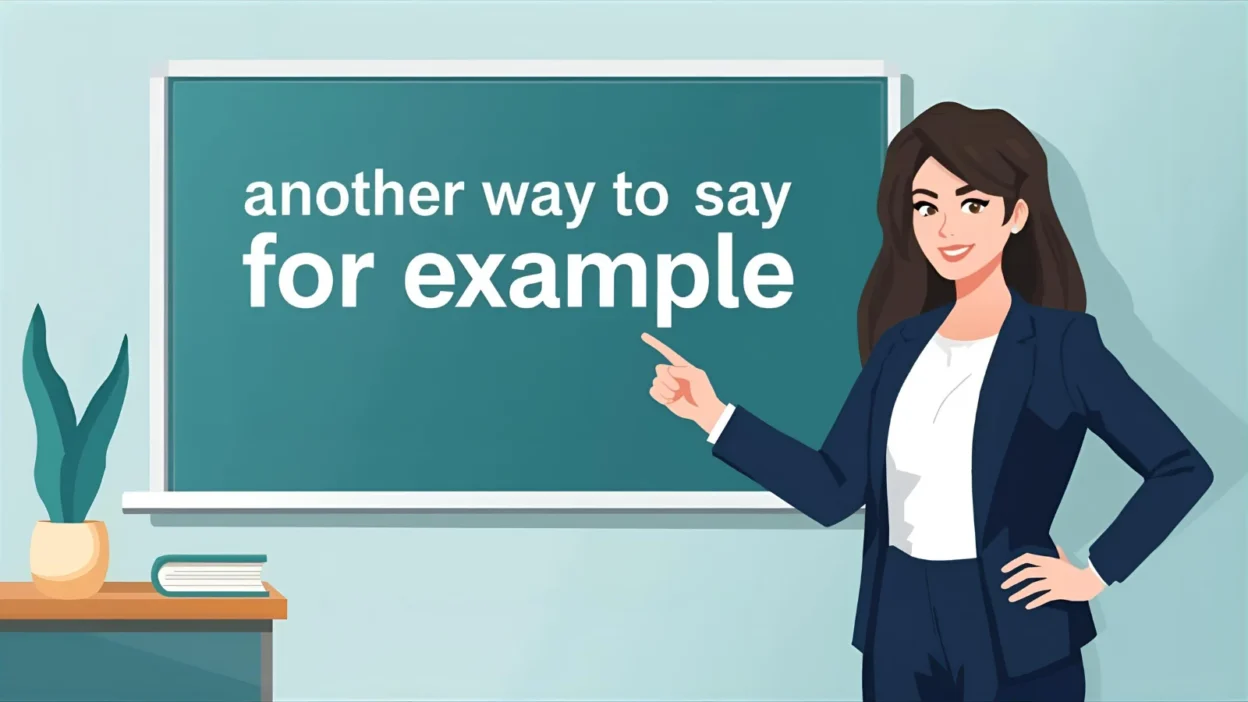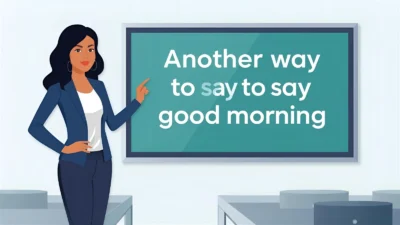The phrase “for example” is one of the most widely used expressions to clarify ideas, support points, and introduce illustrations. While effective, relying on it too often can make your writing or speaking sound repetitive.
By learning alternatives, you’ll be able to adapt your tone, match your audience, and make your communication richer.
This guide explores 25 alternatives to “for example,” each with its meaning, detailed explanation, real-world scenario, best context, and tone. Use them strategically to enhance your writing, presentations, and conversations.
1. Such As
Meaning: Introduces specific items that fit into a broader category.
Detailed Explanation: Flows naturally inside a sentence and feels less forceful than “for example.”
Scenario Example: The museum has many famous paintings, such as Monet’s Water Lilies.
Best Use: Formal or semi-formal writing, reports.
Tone: Polished, professional.
2. For Instance
Meaning: Provides a single case that supports a general idea.
Detailed Explanation: Slightly more conversational than “for example,” but still widely accepted in all contexts.
Scenario Example: Many people enjoy outdoor sports. For instance, cycling is hugely popular.
Best Use: General writing, presentations, essays.
Tone: Neutral, accessible.
3. Namely
Meaning: Identifies something with precision.
Detailed Explanation: Stronger and more exact than “for example,” often used to narrow a statement.
Scenario Example: Only one person passed the test—namely, Sarah.
Best Use: Academic writing, formal reports.
Tone: Formal, precise.
4. In Particular
Meaning: Highlights something especially relevant.
Detailed Explanation: Unlike “for example,” this phrase puts focus on a standout case.
Scenario Example: He likes music, in particular, jazz and classical.
Best Use: Analysis, opinions, speeches.
Tone: Emphatic, reflective.
5. To Illustrate
Meaning: Introduces an example to explain a point.
Detailed Explanation: Works well when clarifying complex ideas.
Scenario Example: To illustrate, consider how bees communicate with dances.
Best Use: Teaching, presentations, explanatory writing.
Tone: Educational, explanatory.
6. Like
Meaning: Lists examples informally.
Detailed Explanation: Very natural in conversation but not suitable for professional writing.
Scenario Example: I enjoy outdoor activities like hiking and swimming.
Best Use: Informal conversation, casual writing.
Tone: Relaxed, conversational.
7. Say
Meaning: Introduces a hypothetical example.
Detailed Explanation: Common in speech, suggests an imagined case.
Scenario Example: Say you lose your wallet—what would you do?
Best Use: Explanations, informal discussions.
Tone: Casual, imaginative.
8. To Give You an Example
Meaning: Clearly signals an example is coming.
Detailed Explanation: Stronger and more direct than “for example.”
Scenario Example: To give you an example, our revenue doubled last year.
Best Use: Presentations, teaching, emails.
Tone: Clear, polite.
9. Specifically
Meaning: Narrows general ideas into exact details.
Detailed Explanation: Adds precision rather than variety.
Scenario Example: We need better results—specifically in customer service.
Best Use: Reports, analysis, business writing.
Tone: Sharp, formal.
10. Consider
Meaning: Invites reflection on a particular case.
Detailed Explanation: Often used in persuasive or academic writing.
Scenario Example: Consider a freelancer without contracts—they risk nonpayment.
Best Use: Essays, persuasive writing.
Tone: Thoughtful, persuasive.
11. Let’s Say
Meaning: Sets up a hypothetical scenario.
Detailed Explanation: Engages the audience and simplifies explanations.
Scenario Example: Let’s say you save 10% of your income monthly.
Best Use: Teaching, presentations, coaching.
Tone: Conversational, engaging.
12. Among Others
Meaning: Suggests more examples beyond those listed.
Detailed Explanation: Keeps lists open-ended.
Scenario Example: She speaks French, Spanish, and German, among others.
Best Use: Academic, resumes, summaries.
Tone: Formal, neutral.
13. Including
Meaning: Adds items within a group.
Detailed Explanation: Concise and professional but less emphatic than “for example.”
Scenario Example: The package includes meals and lodging.
Best Use: Technical writing, business documents.
Tone: Neutral, professional.
14. As an Example
Meaning: Offers a case to clarify a point.
Detailed Explanation: Structured, common in formal contexts.
Scenario Example: As an example, look at Tesla’s growth model.
Best Use: Essays, reports, teaching.
Tone: Informative, neutral.
15. Case in Point
Meaning: Presents a strong supporting case.
Detailed Explanation: Often used persuasively.
Scenario Example: Remote work increases productivity. Case in point: last quarter’s results.
Best Use: Debates, persuasive writing.
Tone: Assertive, confident.
16. One Example Is
Meaning: Draws attention to a single case.
Detailed Explanation: Gives weight to a particular instance.
Scenario Example: One example is Amazon’s AI-driven logistics.
Best Use: Business, explanations, reports.
Tone: Clear, structured.
17. Imagine
Meaning: Encourages visualization of a case.
Detailed Explanation: Works well in storytelling or persuasion.
Scenario Example: Imagine launching a product with zero budget.
Best Use: Speeches, creative writing.
Tone: Engaging, informal.
18. Suppose
Meaning: Offers a reflective, hypothetical case.
Detailed Explanation: Often used in reasoning or teaching.
Scenario Example: Suppose you invest $100 monthly—how much would you have in 10 years?
Best Use: Coaching, lessons, essays.
Tone: Analytical, curious.
19. Exhibit A
Meaning: Introduces a dramatic or humorous example.
Detailed Explanation: Borrowed from courtroom language.
Scenario Example: He claims he eats healthy. Exhibit A: his snack drawer.
Best Use: Informal, blogs, commentary.
Tone: Humorous, dramatic.
20. A Good Example Is
Meaning: Presents an ideal supporting case.
Detailed Explanation: Friendly and clear.
Scenario Example: A good example is Canva, which made design easy.
Best Use: Teaching, guides, case studies.
Tone: Warm, instructional.
21. As Seen In
Meaning: Cites a recognized source or case.
Detailed Explanation: Adds authority by pointing to evidence.
Scenario Example: As seen in Apple’s launches, simplicity drives appeal.
Best Use: Business writing, case studies.
Tone: Authoritative, confident.
22. Including But Not Limited To
Meaning: Ensures the list isn’t restrictive.
Detailed Explanation: Common in contracts and technical contexts.
Scenario Example: Coverage includes but is not limited to theft and damage.
Best Use: Legal writing, formal policies.
Tone: Technical, precise.
23. That Is
Meaning: Clarifies or restates a point with examples.
Detailed Explanation: Often explanatory rather than illustrative.
Scenario Example: We need to improve external operations—that is, logistics and delivery.
Best Use: Analysis, documentation.
Tone: Formal, analytical.
24. Consider the Case Of
Meaning: Introduces a formal or illustrative case.
Detailed Explanation: Frames the example like a case study.
Scenario Example: Consider the case of Netflix moving to streaming.
Best Use: Academic writing, articles, presentations.
Tone: Structured, formal.
25. Take X as an Example
Meaning: Guides the audience to reflect on a case.
Detailed Explanation: Conversational, yet direct.
Scenario Example: Take Uber as an example of disruption in transport.
Best Use: Business, opinion writing, speeches.
Tone: Illustrative, straightforward.
Conclusion
Although “for example” is a go-to phrase, using it too frequently can dull your expression. With these 25 alternatives, you can adjust your language to suit different contexts—whether you want to sound formal, casual, persuasive, or explanatory. By diversifying your phrasing, you make your communication sharper, more engaging, and more professional.



